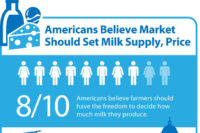In written testimony provided to members of the U.S. House of Representatives Budget Committee, IDFA President and CEO Connie Tipton outlined how the government's outdated system for milk pricing is contributing to spiraling costs in these programs. U.S. Rep. James McGovern (D-Mass.) placed the statement in the committee's official record.
“Rising milk costs are making it increasingly difficult for processors and school districts under the U.S. Department of Agriculture's school lunch program to meet program requirements within budget,” Tipton said. “The budget for the U.S. Department of Agriculture's child nutrition programs must serve more than 30 million students every day, and school foodservice directors across the country are struggling to make nutritious meals because reimbursement rates from USDA have not kept pace with rising milk and food costs."
In her written statement, Tipton urged committee members to consider increasing allocations for subsidized nutrition programs, including making direct milk reimbursements, which are now limited to only some schools, available to all schools in the country.
Tipton explained that several factors have contributed to the rising cost of milk and dairy products, including higher energy and feed costs and increased export demand, as well as the current federal milk pricing system. For the past 70 years, the government has used the Federal Milk Marketing Order system, overseen by USDA, to set minimum prices for fluid milk. The system initially was designed to ensure that all areas of the country would have ready access to a strong milk supply.
The same pricing program continues to set minimum prices today, even though new technology and an effective national transportation system ensure a steady supply of milk throughout the country. In her testimony, Tipton criticized recent pricing decisions that have raised the cost of farm milk above market levels in several states, and said that USDA currently is considering a proposal to increase milk prices in additional states as well as nationally.
“Instead of doing everything it can to keep milk available and affordable under the current economic situation, the administration is making changes that result in even higher milk prices,” Tipton said. “While Congress was passing the new 2008 Farm Bill, with increased government funding to protect dairy farmers from price downturns, USDA raised farm milk prices throughout every county in 14 Southeastern and Appalachian states with the implementation of a controversial Federal Milk Marketing Order change.”
The best way to help schools and families meet the challenges of providing nutritional meals, Tipton concluded, is for Congress to increase the funding for federal feeding programs and to consider reforming the outdated federal milk pricing system.


